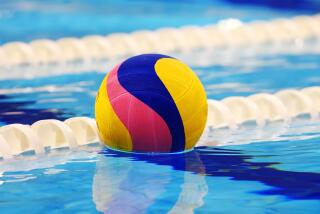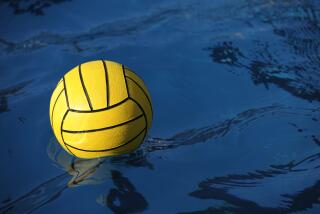Summertime, and the Swimming Is Easy . . . Unless It’s for Water Polo
- Share via
FULLERTON — Early Thursday morning--the 5:45 a.m. type of early--Sunny Hills High School water polo players were toe-testing the temperature of the pool at Independence Park of Fullerton.
The 25 players, who were there by choice, play for the Trojan water polo club, which is Sunny Hills’ summer team.
In addition to two-hour morning workouts five days a week, the players also lift weights three times a week, play league games at night twice a week and participate in tournaments on weekends.
Kids all over the county are getting their feet wet the same way, and they are each paying from $50 to $300 for the privilege.
The reason: Every successful water polo team is dependent on a strong summer program.
“Summer water polo is a tremendously important part of the school program,” Sunny Hills Coach Keith Nighswonger said.
“Look at basketball or any sport--they go year-round as well. A kid that plays in the summertime can pick up a world of experience.
“We’ll play 55 to 60 games (over a six-week schedule). In a successful high school season, which includes playoffs, you play 25 to 30 games. You pick up almost two years’ experience in the summer. You can’t teach that.”
Work in the summer is geared toward winning in the fall.
“The teams that play in the summer are the ones that are the most successful (in the fall),” Villa Park Coach Jeff Ehrlich said.
“I think in the summer they learn to get tough,” he said. “They learn the tricks that go on under water. They learn survival.”
A good example is El Toro, which lost most of the starters from its 1988 Southern Section 3-A Division championship team. Thanks in part to their summer schedule, the Chargers won the title again in 1989.
El Toro operates its summer program with a twist. The Charger varsity plays against community college teams and junior varsity squads from four-year universities. El Toro’s JV team plays in varsity summer leagues.
“We like to play each squad a notch above what they’re supposed to,” El Toro Coach Don Stoll said. “It can be hard, and sometimes we lose players who don’t like getting beat 15-4 in the summer. But around here, we like to say the boys of summer make the men of September.”
Still, summer water polo is not just hard work. Coaches, players, officials and parents say they love and enjoy it.
“I really believe most of the people out there in the summertime have a general love for the sport,” Nighswonger said. “I enjoy the people. It’s almost kind of a social thing--you get to see them (parents, coaches and referees) every summer.”
Nighswonger makes no apologies for getting the kids up early in the summer. “Most of the time I keep these kids busy,” he said. “I find that the more you ask and expect, the more you get. In the summer you can measure what the commitment is going to be for the following season.”
Club play provides an opportunity for members of a high school team to play together in the summer. Though any player may play for any club, most join for the club led by their high school coach.
Each player pays a participation fee, which includes a $25 registration fee to U.S. Water Polo for insurance and to help pay officials.
U.S. Water Polo, which selects the Olympic and National teams, divides the country into seven zones for governing purposes. Orange County is in Zone 7, where there are two districts--Southern Pacific and Pacifica Southwest.
The county is in the Southern Pacific District, which stretches north to San Luis Obispo, east to Indio and south to San Clemente. It contains approximately 3,500 athletes and 100 registered teams.
“U.S. Water Polo sanctions every tournament at all different age groups,” said George Ratkovic, Zone 7 chairman. “U.S. Water Polo provides liability insurance for the club, accident insurance for the players and officials for the games. If a team or player plays outside U.S. Water Polo (in a nonsanctioned event), they are not covered.”
U.S. Water Polo also puts on clinics for coaches and athletes.
Though most summer leagues are sanctioned by U.S. Water Polo, not all are. Leagues are generally organized by coaches, who establish the participation fee that goes toward pool rental and payment of officials.
The leagues are competitive, but the goal is experience, not winning.
“The summer is more low-key,” Nighswonger said. “That’s the nice thing about the summer--that everyone out there is out there to improve their game. In the fall it’s a much more competitive situation. There’s a different tone.”
Tournaments, however, tend to bring out the competitive spirit in the summer. Up to 16 teams gather over the weekend for four or five games, and two officials are used. League games generally employ only one official.
In addition to summer leagues, summer camps are being started for water polo players.
The Orange County Water Polo Academy at Villa Park High School will be the county’s first camp. Its initial session runs next week, Monday through Friday, and its second session is scheduled June 25-29. Cost is $175 for the day camp, which is open to players between the ages of 12 and 18.
Perhaps water polo’s most prestigious summer camp is at Stanford, where participants stay overnight in the dorms for $425 a week. Day campers pay $325. Pepperdine and Cal State Long Beach also have camps.
Don Cholodenko, Capistrano Valley water polo coach, said college camps have helped his players.
Five years ago, Capistrano Valley “was the worst team in the county,” Cholodenko said. After his second year at the school, he had about 12 players attend a camp at Pepperdine.
This past season, Capistrano Valley finished 27-2, losing to South Coast League rival El Toro in the 3-A final.
But camps are generally designed for young players who need to work on improving their technique.
“Traditionally, your better players don’t come to camps; it’s usually the younger kids,” Ehrlich said. “Your 17- to 18-year-olds are working during the day and then they play at night in leagues, so it can be tough.”
Cholodenko doubts the helpfulness of camp for an older player because “most of the stuff you hear at the camps--they’ve heard it before. It becomes a question of how much you are going to pick up for the money you pay.”
Generally, money is not a major concern when it comes to water polo. Some schools have booster clubs that hold fund-raisers for trips to such places as Hawaii and Australia for games. Other schools leave money matters up to the individual.
“(Dealing with water polo) financially--that’s minimal,” said Shelley Woolery, whose son, Josh, was a senior on the Villa Park team this season. “It’s mostly just buying a small piece of cloth (bathing suit). It’s not like going out and buying new cleats every time they wear out.”
And the time commitment doesn’t appear to be a problem for anyone--even parents.
“(Summer water polo) takes up a lot of our time,” Shelley Woolery said. “But it’s better that than visiting your kid in jail.”
“I enjoy the time,” said Stoll, who has some concern about being consumed by the sport. “I told the kids yesterday that practice was going to be from 2:30 to 4:30 and two kids raised their hands and asked, ‘Can it go to five?’ I said, ‘I’ll be here.’ ”
More to Read
Get our high school sports newsletter
Prep Rally is devoted to the SoCal high school sports experience, bringing you scores, stories and a behind-the-scenes look at what makes prep sports so popular.
You may occasionally receive promotional content from the Los Angeles Times.






